
Hands on Review: Monster Mill MM-3 Grain Mill!
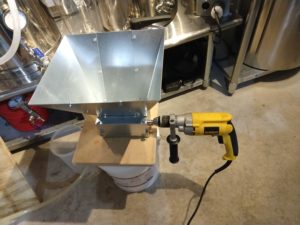
Updated: 5/14/2024
This review is by Homebrew Finds Contributor Brad Probert. Brad is an engineer, expert homebrewer and experienced reviewer. Grab a link to Brad’s website at the end of this review.
Monster Mill MM-3
I started milling my own grains not too long after I switched to all-grain. At first I thought the idea was laughable to mill my own grains- why buy something and do the work myself, when I could get it done for free at the homebrew shop? But once my process had stabilized a fair amount, I became frustrated by my inability to hit the recipe’s planned OG. On my batches where my gravity was lower than predicted, I found a notable number of fully intact grains in the spent grains from my mash. Aiming for consistency, I wanted to make sure all my grains were always crushed, so I bought a 2-roller grain mill. That worked well, but if I wanted to optimize mash efficiency, I was always dancing on the edge of a stuck mash.
The 3-roller mill from Monster Brewing Hardware passes through a first pair of rollers that have a fixed gap. That is machined to be 0.060”, with the intention of doing a minimal crush to soften the inside of the grain without really breaking the husk. After the first pair of rollers, it passes through the gap that you can adjust to your liking. The instructions provided with the mill recommend 0.045” for a medium crush, 0.055” for a coarse crush, and 0.038” for a fine crush. But of course the beauty of having your own mill is you can adjust it as you want, based on what works best for you.
The MM-3 3-roller mill comes with some options. The base rollers are 1144 steel alloy that is durable for long life, but can get some surface rust if used in a non-climate-controlled area, or if you wet mill your grain. For those homebrewers, they offer a stainless steel roller option, which they say has the same durability as the steel alloy base rollers. If you are a manic homebrewer, they offer a 3rd option with their MM-3 Pro series, which has heat treated rollers. These apparently have about 10x the life durability, but the price tag roughly doubles over the base MM-3.

The other option to choose from is the drive shaft size. Standard is a 1/2″ drive, but 3/8” is available as a smaller option. The 3/8” really isn’t recommended since 3/8” drive drills typically don’t have the torque to drive this mill. It can also be hard to find a cordless drill with enough torque to drive it, so Monster Mill recommends a corded drill. If you order the grain hopper from Monster Mill, it comes standard in galvanized 20-gauge steel, or optional stainless steel. Galvanized steel is corrosion resistant, so the only real advantage of stainless for your grain hopper is the “bling effect”.
Limited Time Availability Info:
In late April Monster Brewing Hardware announced an issue with one of their vendors. They are working to replace the vendor, but in the mean time what’s available is… what’s available.
Place your order now to avoid extended delivery delays
Monster Mills and Accessories at Monster Brewing Hardware
Compare Prices & Monster Mill Offerings, Review Continues Below
- Monster Mills and Accessories at Monster Brewing Hardware
- Monster Mills and Accessories at MoreBeer
- Monster Mills at Beer & Wine Hobby
- Search Amazon for “Monster Mill” – offerings vary
This article contains affiliate links. We may make a small percentage if you use our links to make a purchase. You won’t pay more and you’ll be supporting Homebrew Finds and more content like this. Thank you for your support!
When shopping for a mill, it’s important to recognize that even if a product looks the same/similar in a picture, there’s more to it than the photo. For example, there is a similar 3-roller mill in the market at a lower price. However, what you can’t tell from the picture is that the rollers are made of a cheaper steel that doesn’t wear as well, and uses non-sealed bearings which are prone to grain dust causing wear problems. Fred Francis, the owner of Monster Mill makes a point of sourcing all of his raw materials from the U.S., and assembling the mills in Georgia. Rather than chase the lowest price point in the market down to the bottom, he focuses on his American supply base and keeping high quality design/materials to ensure a robust product that stands up well with word-of-mouth recommendations
Hands on Trial
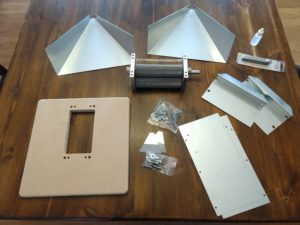 Full Contents of Mill and Accessories Kit
Full Contents of Mill and Accessories Kit
The first thing I noticed was how meticulously the packaging was designed. Seeing the simple flat box on my doorstep, I almost contacted Monster Mill to tell them they forgot to ship my grain hopper and base. Luckily I opened the box first, to avoid my embarrassment. Parts were nested in specific spots, well supported for protection in shipping and making the most use of the space available. The smaller box size makes shipping cheaper, but it also means you don’t have to deal with shipping something back because it arrived bent or scratched. I review a lot of gear, and the care taken in designing packaging is usually a good indicator of the quality of the design of the product.
While unpacking the mill, I noticed the rollers had a lot of residual machining oil on them. I typically read instructions, but on this occasion, I dug in and gave them a good cleaning to get rid of the oil. After I saw the rust forming within a seemingly amazing short amount of time, I read the manual- “Before using your mill the first time, run a pound or so of malt through it a few times to clean the rollers. After milling, brush the grain dust off the rollers with a dry brush or use compressed air. Do not use water.” Luckily, with use of a nylon bristle brush, and the suggestion of running grain through it, the rust was no longer visible. Learn from my mistake.
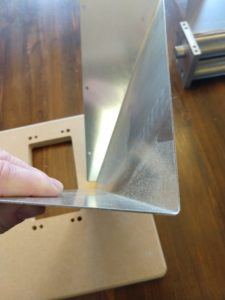 Heavy Gauge Steel with Rounded Edges
Heavy Gauge Steel with Rounded Edges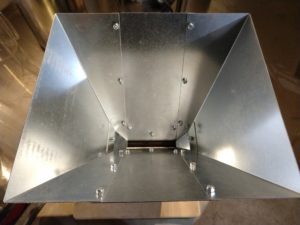 Assembled Grain Hopper
Assembled Grain Hopper
The hopper was straightforward to assemble with the little machine screws, washers, and nylon-insert lock nuts. And another good note of attention to detail, the galvanized steel hopper walls had no sharp edges. A combination of the sturdy gauge, and good machining practices left me with unscathed hands at the end of assembly.
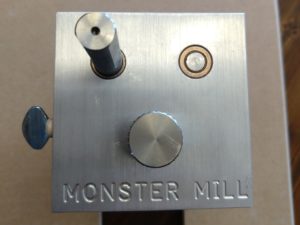 Roller Gap Adjustment Knob and Input Drive Shaft
Roller Gap Adjustment Knob and Input Drive Shaft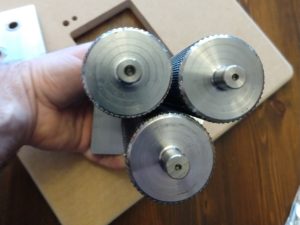 Axle Shafts Solid Extensions of Rollers
Axle Shafts Solid Extensions of Rollers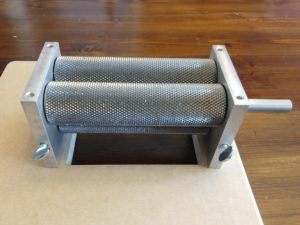 Mill Body without Hopper
Mill Body without Hopper
Adjustment of the roller gap was tricky. With the mill mounted to the base, I couldn’t get a straight shot in between the adjustable roller and the drive roller. I made use of feeler gauges that had a 45-degree angle bent into them and this worked fairly well. To be truly accurate, I would’ve needed to unbolt the mill from the base, but that seemed like too much work. I also tested out their recommendation on drills. I tried my cordless drill [DeWalt Model DCD771 20V] and wasn’t able to make it even move, so I went with my corded drill [DeWalt Model DW236] to power through it.
For this evaluation, I set up a small mash experiment. I had previously run a mash conversion efficiency trial on my 2-roller mill, to determine the gap to use with that mill. There are of course a million variables contributing to mash efficiency. I tried to minimize those effects by mashing with grain from the same batch, same water adjustment salts/acid, same mash profile, and same mash tun. From that experiment, it showed a 7% improvement in mash efficiency with grain milled at 0.026” versus 0.034”. So that’s been my standard set-up since then. The downside from this was semi-frequent stuck mashes and the need to supplement my grain bill with rice hulls to try to counteract this effect.
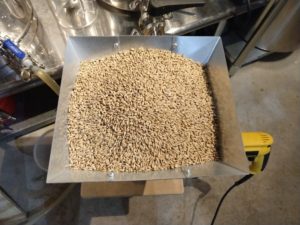 9 Pounds of Grain in Hopper
9 Pounds of Grain in Hopper
For the Monster Mill MM-3, I used grain from a single 55-lb bag of malt (Viking Xtra Pale malt from MoreBeer). Mashed it in a Chapman Thermobarrel – Hands on Review – while running recirculation through my Blichmann RIMS Rocket – Hands on Review. All of these trials used 9 lbs. of the malt, combined with brewing salts and acid to reach a mash pH measured of 5.3. I mashed for an hour at 149F, then raised temperature to 168F for a 10 minute mash out. I collected all the first runnings in my kettle, then added all of the sparge water to the mash tun, stirred things up, recirculated for 10 minutes, then drained all of that into the boil kettle as well.
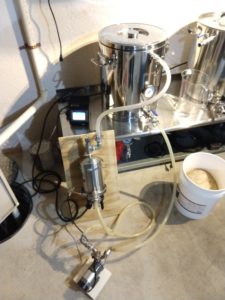 Mash Conversion Experiment Set-up
Mash Conversion Experiment Set-up
Trial 1 Baseline
The first batch I did was to establish my baseline with this new mash tun and new grain, using my 2-roller mill set to 0.026” gap. With this configuration, I achieved a mash efficiency of 80%. And unsurprisingly, I got a stuck mash at one point while recirculating which I had to break free from the false bottom and slow down the recirculation pump flow rate.
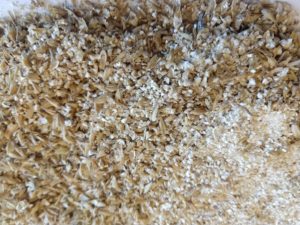 Baseline: 026-inch 2-Roller Mill Close-up
Baseline: 026-inch 2-Roller Mill Close-up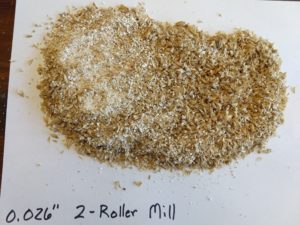 Baseline: 026-inch 2-Roller Mill
Baseline: 026-inch 2-Roller Mill
Trial 2
For the second batch, I used the MM-3 set to 0.035” gap. Qualitatively, I could see when comparing the crushed grains, that the MM-3 had much better grain husk structure to support filtering in the mash bed. The 2-roller with the finer crush had a lot of grains pulverized to a flour-like consistency. With the MM-3 at 0.035” gap, I achieved a mash efficiency of 78%. With only a 2% difference to the first run with the 2-roller mill, this could very well have just been measurement variation.
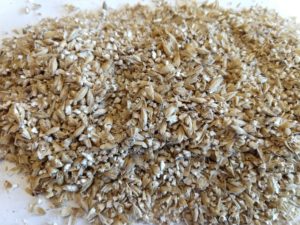 035-inch 3-Roller Mill Close-up
035-inch 3-Roller Mill Close-up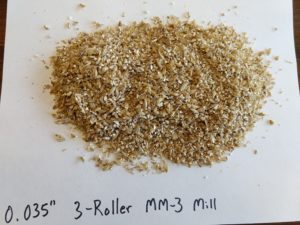 035-inch 3-Roller Mill
035-inch 3-Roller Mill
Trial 3
For the third batch, I adjusted the MM-3 down slightly to a 0.033” gap. I also ran some grain through my 2-roller mill with this same 0.033” gap to do a qualitative/visual comparison. The 2-roller mill had a small amount of whole kernels that hadn’t been cracked at this gap setting, whereas the 3-roller MM-3 had cracked every kernel. Some were more intact than others, but all had been cracked, with the endosperm exposed to soaking in mash water to extract its sugars. This 0.033” gap on the MM-3 resulted in an 80% mash efficiency.
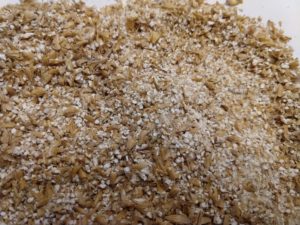 033-inch 2-Roller Close-up
033-inch 2-Roller Close-up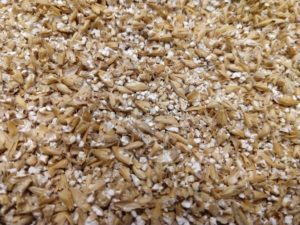 033-inch 3-Roller Close-up
033-inch 3-Roller Close-up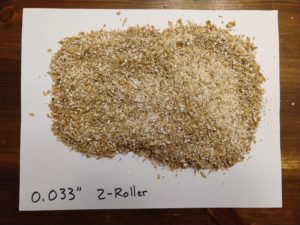 033-inch 2-Roller Mill
033-inch 2-Roller Mill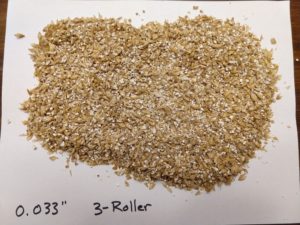 033-inch 3-Roller Mill
033-inch 3-Roller Mill
Conclusions
In conclusion, the MM-3 was able to achieve the same mash efficiency as my 2-roller mill, but do so at a gap setting that didn’t leave me prone to stuck mashes. And while brewing electric with a RIMS system, you like to take advantage of the control and go about doing other things during mashing without having to babysit to avoid scorched wort or dry running your pump. So that’s a significant result for my electric brewing setup. The quality of the mill is great, and seems heavy duty. Definitely seems like it has a long life ahead of it.
More Pictures Below…
Get the Gear
- Monster Mills and Accessories at Monster Brewing Hardware
- Monster Mills and Accessories at MoreBeer
- Monster Mills at Beer & Wine Hobby
- Search Amazon for “Monster Mill” – offerings vary
Mentioned in This Review:
- Hands on Review: Chapman Thermobarrel Stainless Steel Mash Tun
- Hands on Review: Blichmann Engineering RIMS Rocket
- Viking Xtra Pale malt from MoreBeer
- DeWalt Model DW236 Corded Drill affiliate link, note that multiple variations of this product may be available, as such a different version may appear at this link
Get a Deal on Bulk Grain
Homebrew Recipe Kit Deals
Grain Storage Options!
Milling Your Own Grain
For all grain brewers, bulk grain storage goes hand in hand with milling your own grain. If we’re storing bulk quantities of grain to save time and money, we’re probably going to need to mill that grain.
Milling your own grain offers these advantages…
- Gives you control over the crush of your grain. That’s a big factor in efficiency. A mill allows you to fine tune for your equipment and process.
- A mill allows you to save money by buying whole bags of grain.
- Freshly milled grain = better tasting beer.
More Photos
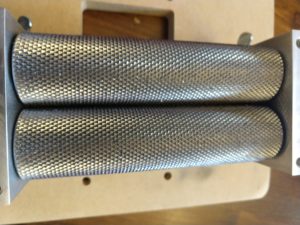 Close up of Mill Rollers
Close up of Mill Rollers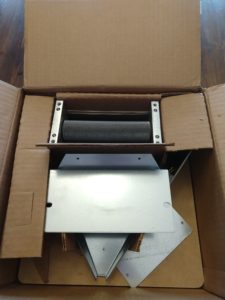 Well Packed Box
Well Packed Box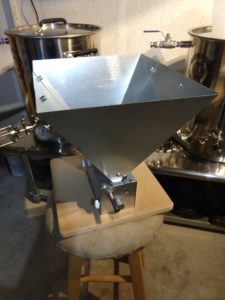 Fully Assembled Mill with Hopper and Base Plate
Fully Assembled Mill with Hopper and Base Plate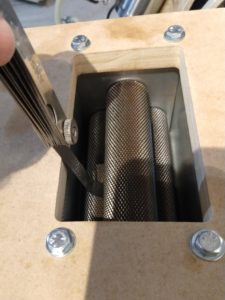 Setting Roller Gap with Angled Feeler Gauge
Setting Roller Gap with Angled Feeler Gauge
More Mill Reviews!
Everything All Grain!
Our resource post on all grain is the source for everything all grain!
More Homebrew Finds!
- Last 50 Finds!
- Top Deals – a curated list of the best deals
- Homebrew Reviews – one of the largest libraries of homebrew reviews in existence!
- Our Top Posts – tips, how-tos, resources posts and more
Special Thanks to Monster Brewing Hardware for providing the unit used for evaluation in this review.
By Brad Probert. Check out Brad’s website – beersnobby.com
pinnedThis post may contain affiliate links. We may make a commission when you use our links. This will never cost you extra. Thank you for supporting Homebrew Finds!
greatdealsMake sure the components you use are compatible and rated for your intended application. Contact manufacturer with questions about suitability or a specific application. Always read and follow manufacturer directions. tag:lnksfxd review:mm rs:7 tag:tpr








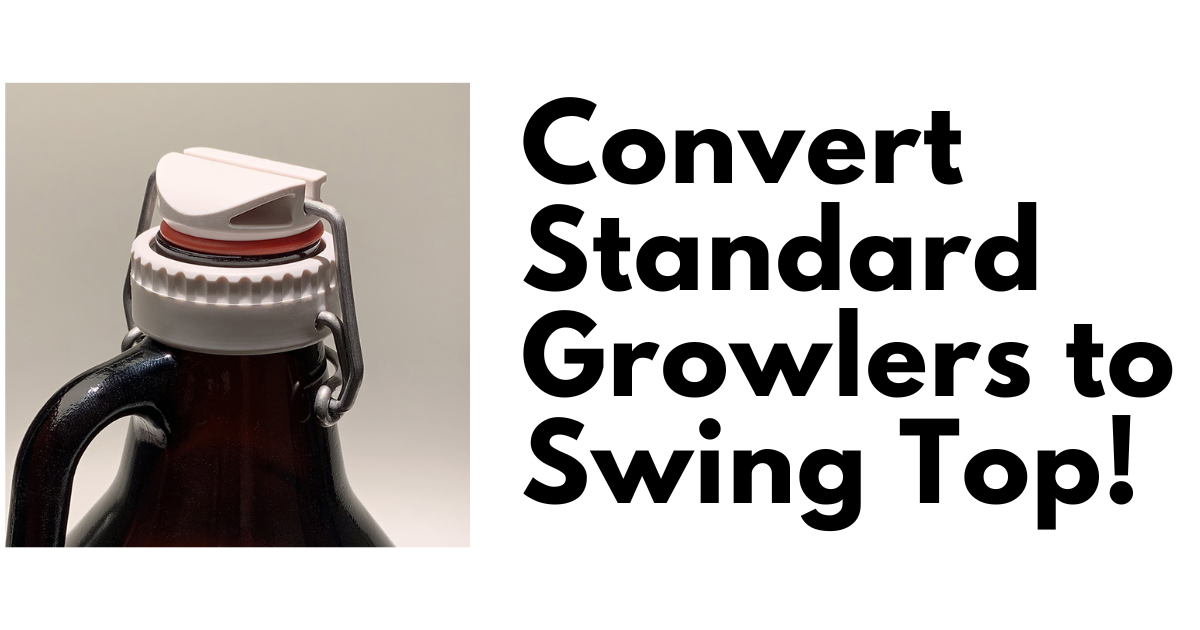
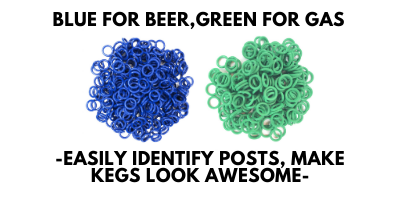








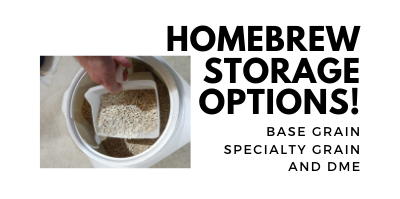
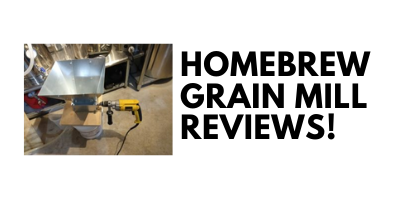

Setting the gap is much easier with the hopper off, and the way I believe is recommended to set the gap. Once set, use a marker to mark the adjustment knobs in case they move.